Citroen DS4 RHD 2015.5 1.G Owner's Manual
Manufacturer: CITROEN, Model Year: 2015.5, Model line: DS4 RHD, Model: Citroen DS4 RHD 2015.5 1.GPages: 436, PDF Size: 10.13 MB
Page 231 of 436

229
2. Inflation
F Adjust the pressure using the compressor (to inflate: switch B in position "I" ;
to
deflate: switch B in position "O" and
press button C ), in accordance with the
vehicle's tyre pressure label (located on the
left hand door aperture).
A l
oss of pressure indicates that the
puncture has not been fully plugged;
contact a CITROËN dealer or qualified
workshop for assistance.
F
R
emove and stow the kit.
F
D
rive at reduced speed (50 mph [80 km/h]
max) limiting the distance travelled to
approximately 120 miles (200 km).
F
T
urn the selector A to the "air"
position.
F
U
ncoil the black pipe H fully.
F
C
onnect the black pipe to the
valve of the wheel. F
C
onnect the compressor's electric plug to
the vehicle's 12 V socket.
F
S
tart the vehicle again and leave the
engine running.
As soon as possible, go to a CITROËN
dealer or a qualified workshop.
You must inform the technician that you
have used this kit. After inspection, the
technician will advise you on whether
the tyre can be repaired or if it must be
replaced.
Practical information
Page 232 of 436

Removing the cartridge
F Stow the black pipe.
F D etach the angled base from the white pipe.
F
S
upport the compressor vertically.
F
U
nscrew the cartridge from the bottom.
Checking tyre pressures /
inflating accessories
Beware of discharges of fluid.
The expiry date of the fluid is indicated
on the cartridge.
The sealant cartridge is designed for
single use; even if only partly used, it
must be replaced.
After use, do not discard the cartridge
into the environment, take it to an
authorised waste disposal site or a
CITROËN dealer.
Do not forget to obtain a new sealant
cartridge, available from CITROËN
dealers or from a qualified workshop. You can also use the compressor, without
injecting any product, to:
-
c heck or adjust the pressure of your tyres,
-
i
nflate other accessories (balls, bicycle
tyres...). F
C
onnect the compressor's electrical
connector to the vehicle's 12 V socket.
F S tart the vehicle and let the engine run.
F
A
djust the pressure using the compressor
(to inflate: switch B in position "I" ;
to
deflate: switch B in position "O" and
press button C ), according to the vehicle's
tyre pressure label or the accessory's
pressure label.
F
R
emove the kit then stow it.
F
T
urn the selector A to the
"Air"
position.
F
U
ncoil the black pipe H fully.
F
C
onnect the black pipe to the
valve of the wheel or accessory.
I
f necessary, fit one of the adaptors
supplied with the kit first.
Page 233 of 436
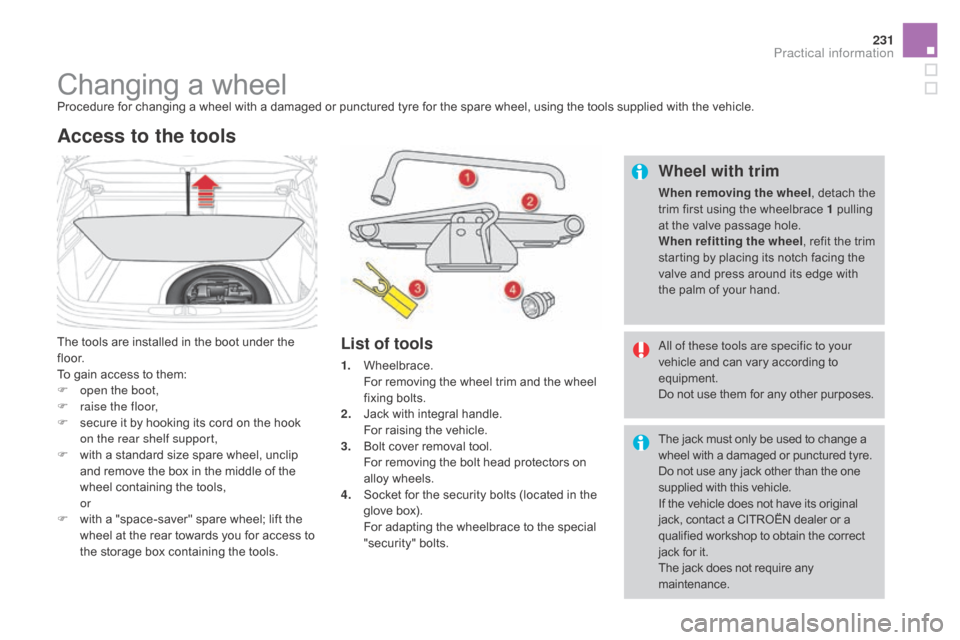
231
Changing a wheelProcedure for changing a wheel with a damaged or punctured tyre for the spare wheel, using the tools supplied with the vehicle.
The tools are installed in the boot under the
f l o o r.
To gain access to them:
F
o
pen the boot,
F
r
aise the floor,
F
s
ecure it by hooking its cord on the hook
on the rear shelf support,
F
w
ith a standard size spare wheel, unclip
and remove the box in the middle of the
wheel containing the tools,
or
F
w
ith a "space-saver" spare wheel; lift the
wheel at the rear towards you for access to
the storage box containing the tools.
Access to the tools
List of tools
1. Wheelbrace. F or removing the wheel trim and the wheel
fixing bolts.
2.
J
ack with integral handle.
F
or raising the vehicle.
3.
B
olt cover removal tool.
F
or removing the bolt head protectors on
alloy wheels.
4.
S
ocket for the security bolts (located in the
glove box).
F
or adapting the wheelbrace to the special
"security" bolts.
Wheel with trim
When removing the wheel , detach the
trim first using the wheelbrace 1 pulling
at the valve passage hole.
When refitting the wheel , refit the trim
starting by placing its notch facing the
valve and press around its edge with
the palm of your hand.
All of these tools are specific to your
vehicle and can vary according to
equipment.
Do not use them for any other purposes.
The jack must only be used to change a
wheel with a damaged or punctured tyre.
Do not use any jack other than the one
supplied with this vehicle.
If the vehicle does not have its original
jack, contact a CITROËN dealer or a
qualified workshop to obtain the correct
jack for it.
The jack does not require any
maintenance.
Practical information
Page 234 of 436
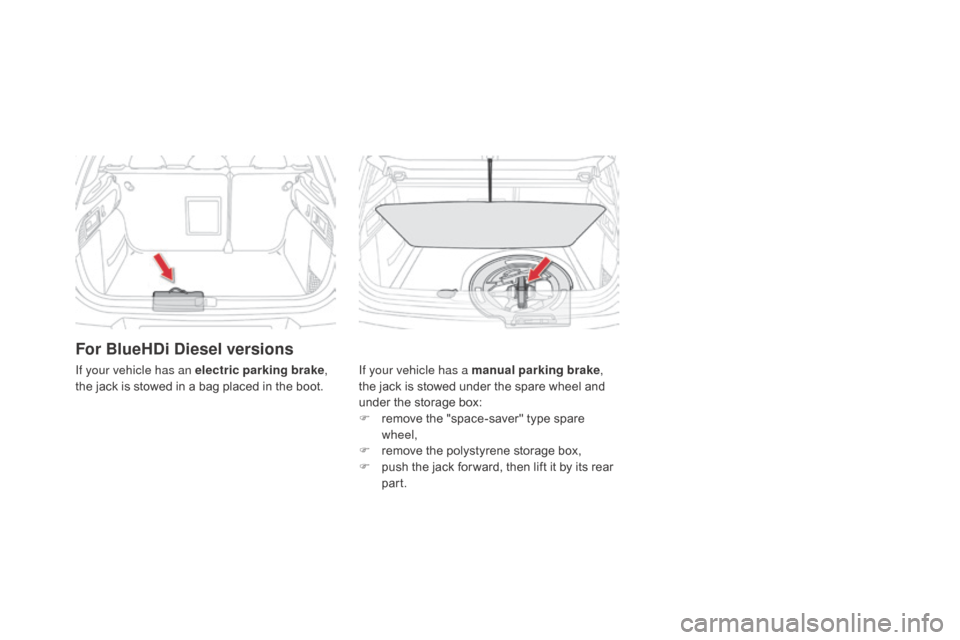
For BlueHdi diesel versions
If your vehicle has a manual parking brake,
the jack is stowed under the spare wheel and
under the storage box:
F
r
emove the "space-saver" type spare
wheel,
F
r
emove the polystyrene storage box,
F
p
ush the jack for ward, then lift it by its rear
part.
If your vehicle has an electric parking brake
,
the jack is stowed in a bag placed in the boot.
Page 235 of 436
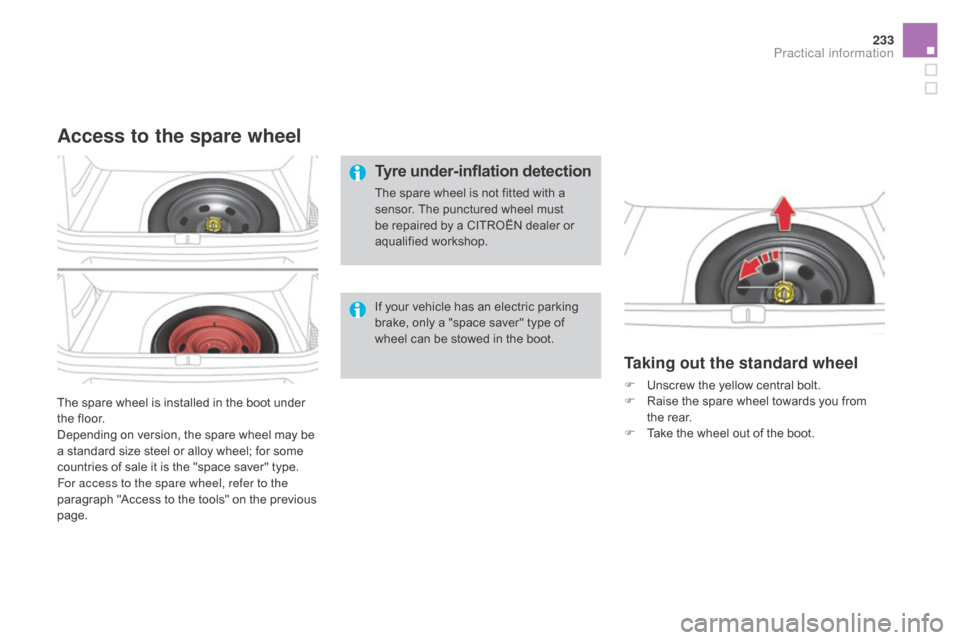
233
The spare wheel is installed in the boot under
the floor.
Depending on version, the spare wheel may be
a standard size steel or alloy wheel; for some
countries of sale it is the "space saver" type.
For access to the spare wheel, refer to the
paragraph "Access to the tools" on the previous
page.
Access to the spare wheel
If your vehicle has an electric parking
brake, only a "space saver" type of
wheel can be stowed in the boot.
Taking out the standard wheel
F Unscrew the yellow central bolt.
F R aise the spare wheel towards you from
the rear.
F
T
ake the wheel out of the boot.
Tyre under-inflation detection
The spare wheel is not fitted with a
sensor. The punctured wheel must
be repaired by a CITROËN dealer or
aqualified workshop.
Practical information
Page 236 of 436
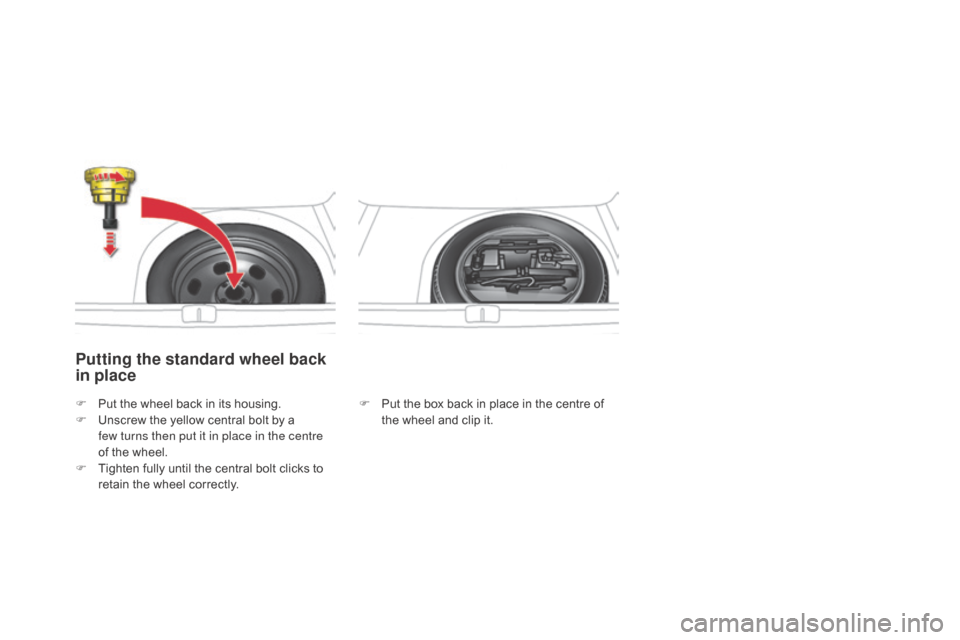
Putting the standard wheel back
in place
F Put the box back in place in the centre of the wheel and clip it.
F
P
ut the wheel back in its housing.
F
U
nscrew the yellow central bolt by a
few
turns then put it in place in the centre
of the wheel.
F
T
ighten fully until the central bolt clicks to
retain the wheel correctly.
Page 237 of 436
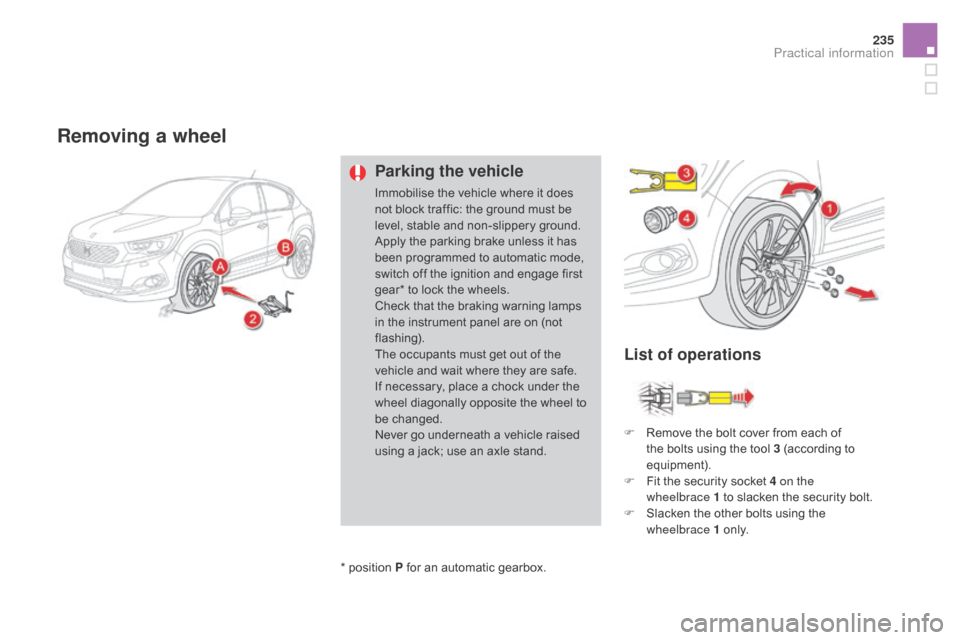
235
Removing a wheel
Parking the vehicle
Immobilise the vehicle where it does
not block traffic: the ground must be
level, stable and non-slippery ground.
Apply the parking brake unless it has
been programmed to automatic mode,
switch off the ignition and engage first
gear* to lock the wheels.
Check that the braking warning lamps
in the instrument panel are on (not
flashing).
The occupants must get out of the
vehicle and wait where they are safe.
If necessary, place a chock under the
wheel diagonally opposite the wheel to
be changed.
Never go underneath a vehicle raised
using a jack; use an axle stand.F
R
emove the bolt cover from each of
the bolts using the tool 3 (according to
equipment).
F
F
it the security socket 4 on the
wheelbrace
1 to slacken the security bolt.
F
S
lacken the other bolts using the
wheelbrace 1 o n l y.
*
position P for an automatic gearbox.
List of operations
Practical information
Page 238 of 436
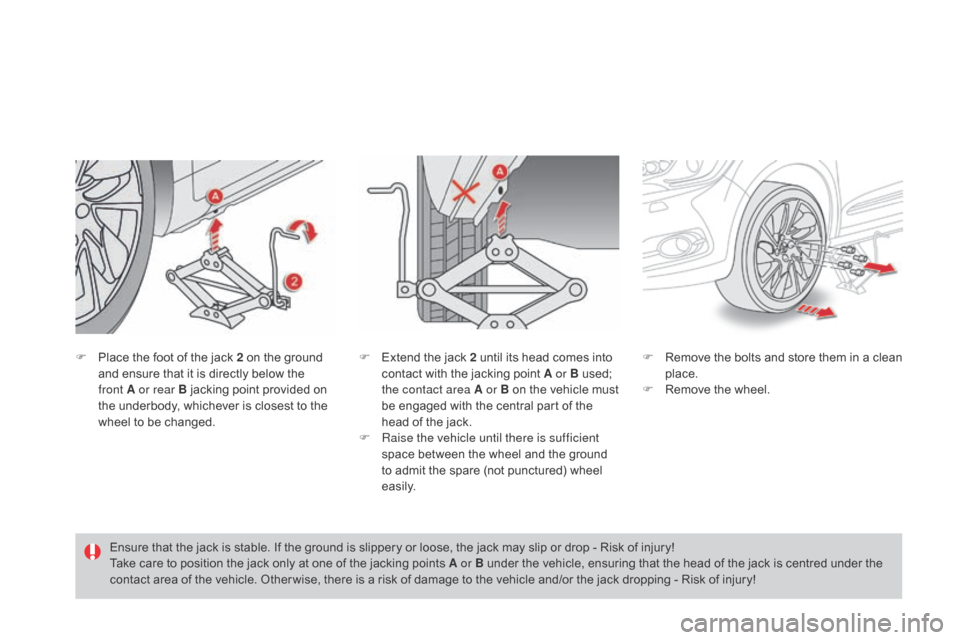
F Place the foot of the jack 2 on the ground and ensure that it is directly below the
front
A or rear B jacking point provided on
the underbody, whichever is closest to the
wheel to be changed. F
R emove the bolts and store them in a clean
place.
F
R
emove the wheel.
Ensure that the jack is stable. If the ground is slippery or loose, the jack may slip or drop - Risk of injury!
Take care to position the jack only at one of the jacking points A or B under the vehicle, ensuring that the head of the jack is centred under the
contact area of the vehicle. Other wise, there is a risk of damage to the vehicle and/or the jack dropping - Risk of injury! F
E xtend the jack 2 until its head comes into
contact with the jacking point A or B used;
the contact area A or B on the vehicle must
be engaged with the central part of the
head of the jack.
F
Ra
ise the vehicle until there is sufficient
space between the wheel and the ground
to admit the spare (not punctured) wheel
easily.
Page 239 of 436
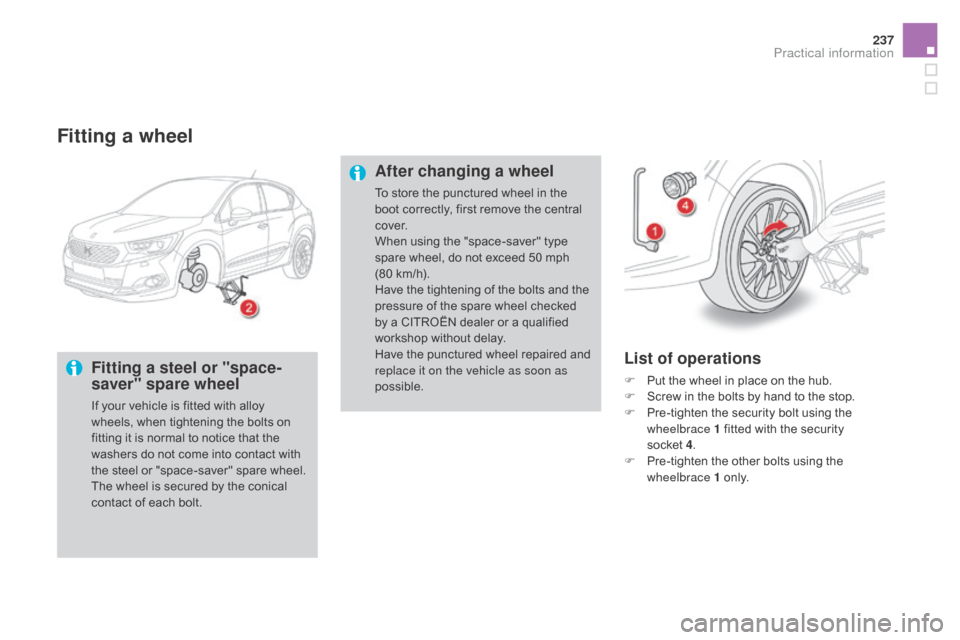
237
Fitting a wheel
Fitting a steel or "space-
saver" spare wheel
If your vehicle is fitted with alloy
wheels, when tightening the bolts on
fitting it is normal to notice that the
washers do not come into contact with
the steel or "space-saver" spare wheel.
The wheel is secured by the conical
contact of each bolt.
List of operations
F Put the wheel in place on the hub.
F S crew in the bolts by hand to the stop.
F
P
re-tighten the security bolt using the
wheelbrace 1 fitted with the security
socket
4 .
F
P
re-tighten the other bolts using the
wheelbrace 1 o n l y.
After changing a wheel
To store the punctured wheel in the
boot correctly, first remove the central
c ove r.
When using the "space-saver" type
spare wheel, do not exceed 50 mph
(80
km/h).
Have the tightening of the bolts and the
pressure of the spare wheel checked
by a CITROËN dealer or a qualified
workshop without delay.
Have the punctured wheel repaired and
replace it on the vehicle as soon as
possible.
Practical information
Page 240 of 436
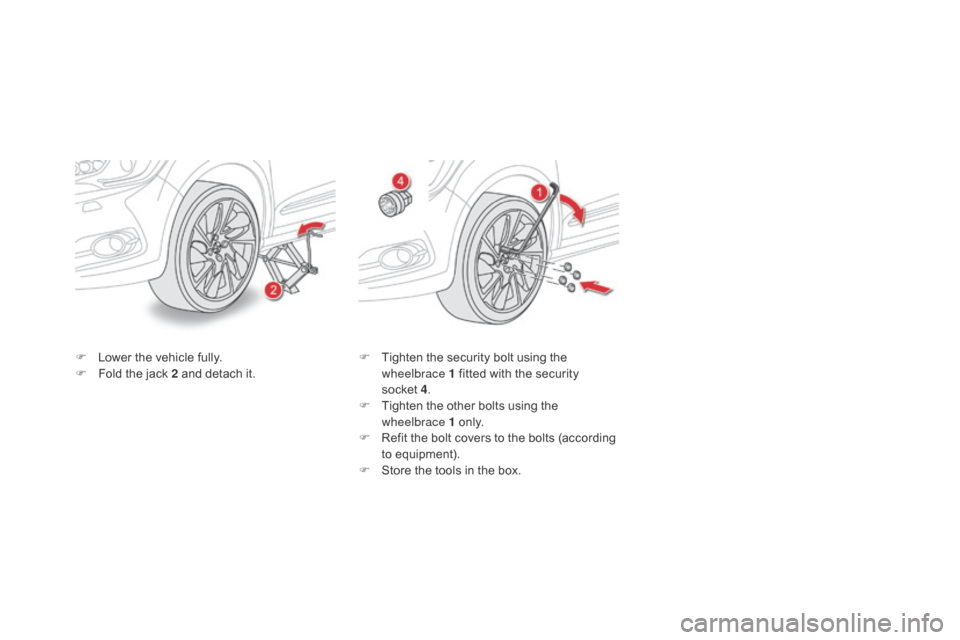
F Lower the vehicle fully.
F F old the jack 2 and detach it. F
T ighten the security bolt using the
wheelbrace 1 fitted with the security
socket
4 .
F
T
ighten the other bolts using the
wheelbrace 1 o n l y.
F
R
efit the bolt covers to the bolts (according
to equipment).
F
S
tore the tools in the box.